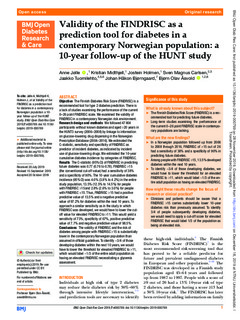| dc.contributor.author | Jølle, Anne | |
| dc.contributor.author | Midthjell, Kristian | |
| dc.contributor.author | Holmen, Jostein | |
| dc.contributor.author | Carlsen, Sven Magnus | |
| dc.contributor.author | Tuomilehto, Jaakko | |
| dc.contributor.author | Bjørngaard, Johan Håkon | |
| dc.contributor.author | Åsvold, Bjørn Olav | |
| dc.date.accessioned | 2020-01-14T09:06:22Z | |
| dc.date.available | 2020-01-14T09:06:22Z | |
| dc.date.created | 2020-01-13T11:02:50Z | |
| dc.date.issued | 2019 | |
| dc.identifier.issn | 2052-4897 | |
| dc.identifier.uri | http://hdl.handle.net/11250/2636103 | |
| dc.description.abstract | Objective The Finnish Diabetes Risk Score (FINDRISC) is a recommended tool for type 2 diabetes prediction. There is a lack of studies examining the performance of the current 0–26 point FINDRISC scale. We examined the validity of FINDRISC in a contemporary Norwegian risk environment.
Research design and methods We followed 47 804 participants without known diabetes and aged ≥20 years in the HUNT3 survey (2006–2008) by linkage to information on glucose-lowering drug dispensing in the Norwegian Prescription Database (2004–2016). We estimated the C-statistic, sensitivity and specificity of FINDRISC as predictor of incident diabetes, as indicated by incident use of glucose-lowering drugs. We estimated the 10-year cumulative diabetes incidence by categories of FINDRISC.
Results The C-statistic (95% CI) of FINDRISC in predicting future diabetes was 0.77 (0.76 to 0.78). FINDRISC ≥15 (the conventional cut-off value) had a sensitivity of 38% and a specificity of 90%. The 10-year cumulative diabetes incidence (95% CI) was 4.0% (3.8% to 4.2%) in the entire study population, 13.5% (12.5% to 14.5%) for people with FINDRISC ≥15 and 2.8% (2.6% to 3.0%) for people with FINDRISC <15. Thus, FINDRISC ≥15 had a positive predictive value of 13.5% and a negative predictive value of 97.2% for diabetes within the next 10 years. To approach a similar sensitivity as in the study in which FINDRISC was developed, we would have to lower the cut-off value for elevated FINDRISC to ≥11. This would yield a sensitivity of 73%, specificity of 67%, positive predictive value of 7.7% and negative predictive value of 98.5%.
Conclusions The validity of FINDRISC and the risk of diabetes among people with FINDRISC ≥15 is substantially lower in the contemporary Norwegian population than assumed in official guidelines. To identify ~3/4 of those developing diabetes within the next 10 years, we would have to lower the threshold for elevated FINDRISC to ≥11, which would label ~1/3 of the entire adult population as having an elevated FINDRISC necessitating a glycemia assessment. | nb_NO |
| dc.language.iso | eng | nb_NO |
| dc.publisher | BMJ Publishing Group | nb_NO |
| dc.rights | Navngivelse 4.0 Internasjonal | * |
| dc.rights.uri | http://creativecommons.org/licenses/by/4.0/deed.no | * |
| dc.title | Validity of the FINDRISC as a prediction tool for diabetes in a contemporary Norwegian population: a 10-year follow-up of the HUNT study | nb_NO |
| dc.type | Journal article | nb_NO |
| dc.type | Peer reviewed | nb_NO |
| dc.description.version | publishedVersion | nb_NO |
| dc.source.journal | BMJ Open Diabetes Research & Care | nb_NO |
| dc.identifier.doi | 10.1136/bmjdrc-2019-000769 | |
| dc.identifier.cristin | 1771214 | |
| dc.description.localcode | © Author(s) (or their employer(s)) 2019. Re-use permitted under CC BY. Published by BMJ. | nb_NO |
| cristin.unitcode | 194,65,20,15 | |
| cristin.unitcode | 194,65,1,0 | |
| cristin.unitcode | 194,65,20,0 | |
| cristin.unitname | Helseundersøkelsen i Nord-Trøndelag | |
| cristin.unitname | MH fakultetsadministrasjon | |
| cristin.unitname | Institutt for samfunnsmedisin og sykepleie | |
| cristin.ispublished | true | |
| cristin.fulltext | original | |
| cristin.qualitycode | 1 | |

